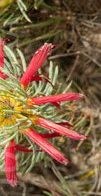Melaleuca macrocarpa
(Melaleuca macrocarpa)

Description
Calothamnus macrocarpus is a plant in the myrtle family, Myrtaceae and is endemic to the south-west of Western Australia. It is an erect shrub with bright red flowers in spring and large, almost spherical fruit. It has a limited distribution near Hopetoun. (In 2014 Craven, Edwards and Cowley proposed that the species be renamed Melaleuca macrocarpa). Calothamnus macrocarpus is an erect shrub with many branches growing to a height of about 2–3 metres (7–10 ft). Its leaves are crowded, 20–30 millimetres (0.8–1 in) long, 1–2 millimetres (0.04–0.08 in) in diameter, cylindrical in shape and taper to a non-prickly point. There are prominent oil glands on the leaves. The flowers are deep red usually in small clusters between the leaves. The petals are 6–8 millimetres (0.2–0.3 in) long, thin, papery and pink to brown. The stamens are arranged in 5 claw-like bundles usually with 26 to 28 stamens per bundle. Flowering occurs from August to December and is followed by fruits which are woody, almost spherical capsules, 13–18 millimetres (0.5–0.7 in) in diameter, which are often hidden in the foliage. Calothamnus macrocarpus was first formally described in 1984 by Trevor Hawkeswood in the botanical journal Nuytsia. The specific epithet (macrocarpus) is derived from the Greek macros meaning "large" or "long" and carpos meaning "fruit" and refers to the prominently large, almost spherical fruit of this species. Calothamnus macrocarpus occurs near the summit of East Mount Barren near Hopetoun in the Esperance Plains biogeographic region where it grows in sand and soils derived from quartzite. Calothamnus macrocarpus is classified as "Priority Two" by the Western Australian government department of parks and wildlife, meaning that it is poorly known and from only one or a few locations, mostly in reserves or national parks. Calothamnus is a genus of shrubs in the family Myrtaceae and is endemic to the south-west of Western Australia. The common names one-sided bottlebrush or claw flower are given to some species due to their having the flowers clustered on one side of the stem or because of the claw-like appearance of their flowers. Calothamnus species are generally medium to tall woody shrubs with crowded leaves. In most species the leaves are crowded and linear in shape, and the flowers are usually arranged in dense clusters. The petals are small and fall off the flower soon after it opens but the stamens are long, numerous and usually bright red.
Taxonomic tree:







